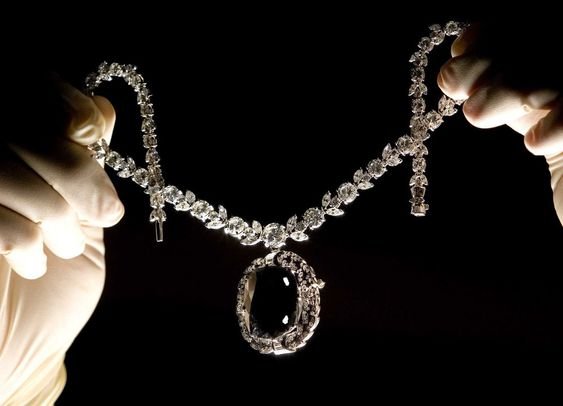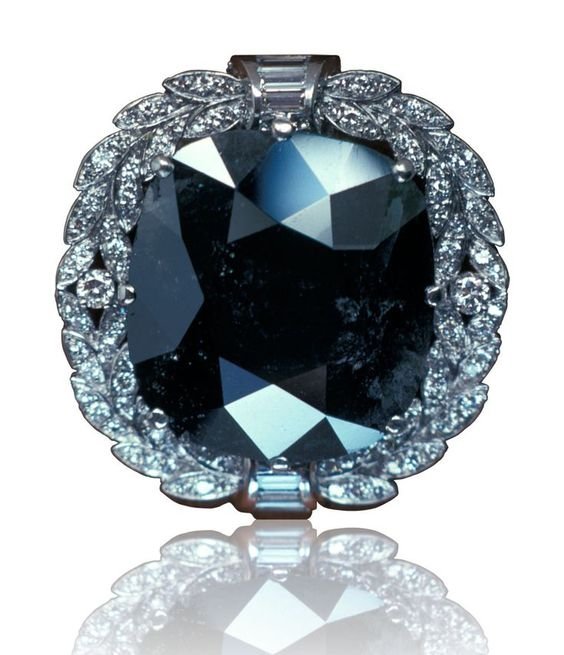Cursed or Coincidence? Exploring the Legend of the Black Orlov Diamond

The Black Orlov diamond and its cursed story has riveted the Gem world ever since it was stolen from its original home in India. Much like many enigmatic diamond tales, the narrative surrounding the seventh-largest black diamond ever, is almost like the plot of a Hollywood thriller. It is replete with unexpected twists, flamboyant characters, brilliant schemes and subtle deceptions. Its tale spans across continents. Despite its supposed curse, this legendary gem continues to exert an irresistible allure and provoke curiosity. This article aims to delve into the riveting history of the Black Orlov, by unraveling its intriguing past and shedding light on its captivating journey through time.

The fascinating tale of the Black Orlov diamond originates in 19th-century India, within the hallowed walls of a temple in Pondicherry. Legend recounts how a daring Hindu monk pilfered a 195-carat black diamond from the revered Brahma statue’s head. This particular diamond was called the Eye of Brahma” for its placement on the statue. Tragedy swiftly befell the monk, and he was murdered, leaving the diamond’s whereabouts shrouded in mystery. Despite exhaustive efforts, the precious gem eluded discovery, setting the stage for a centuries-long enigma that continues to captivate imaginations around the globe.
There are other theories regarding its origin too. Among these alternate narratives,some believe that the diamond’s theft was orchestrated by a French deserter, who purportedly fled with the precious gem to Madras. Another compelling theory traces the history of the Orlov back to the middle of the 18th century, linking it to Nāder Shāh, the formidable king of Persia. According to this account, the diamond adorned the regal collection of Nāder Shāh until his untimely assassination. Subsequently, it is believed to have been looted and was acquired by an Armenian tycoon named Shaffrass. However, there is very scant evidence regarding these theories and the whereabouts of the diamond till the year 1932, when it came into the possession of the European diamond dealer, J.W. Paris.

J.W. Paris remains a mysterious personality, with scant information available about his background. Despite this obscurity, the known fact is that within just a week of his arrival in New York City, he managed to successfully sell the notorious Black Orlov diamond. However, tragedy swiftly laid its hands on him. On April 7th of the same year, Paris ascended to the summit of a towering Manhattan skyscraper nestled in the heart of 5th Avenue. There, amidst the bustling cityscape below, he tragically jumped to his own demise.
The timing of Paris’s demise, so shortly after his involvement with the Black Orlov, has sparked speculation among enthusiasts and skeptics alike. Some conjecture that his untimely death marked the inception of what would become known as the diamond’s curse, adding another layer of intrigue to its already enigmatic history. Whether driven by superstition or mere coincidence, the tragic fate of J.W. Paris cemented the story of the curse of the Black Orlov.

Fifteen years after J.W. Paris’s encounter with the Black Orlov diamond, it found its way into the possession of Russian royalty, specifically Princess Nadia-Orlov, from whom the gem derives its name. Princess Nadia’s association with the diamond added another chapter to its storied history. Amidst the tumultuous backdrop of the 1917 Russian Revolution, Princess Nadia found herself embroiled in the chaos sweeping across her homeland.
The Russian Revolution of 1917 was a pivotal moment in history, as widespread discontent with the autocratic rule of Tsar Nicholas II erupted into mass protests and uprisings. Divisions between social classes deepened, with workers, peasants, and soldiers demanding an end to oppression and inequality. With the October Revolution, the Bolsheviks, led by Vladimir Lenin, seized power in the October Revolution, paving the way for the establishment of the world’s first communist state. The revolution reshaped Russia’s political landscape and had profound implications for global politics. But for our story, the Revolution shaped the history of the Black Orlov.

Faced with grave danger, Princess Nadia-Orlov, like many of her compatriots, sought refuge abroad. Escaping the upheaval, Princess Nadia fled Russia and sought sanctuary in the tranquil environs of Rome, Italy, where she could find solace amidst the turmoil engulfing her homeland. She soon married a Russian Jeweller and came in possession of the diamond. The Curse again worked its dark magic.
On December 2nd, 1947, tragedy struck once again, echoing the grim fate that befell J.W. Paris only fifteen years prior. Princess Nadia, whose life had been intertwined with the enigmatic Black Orlov diamond, met a similarly tragic end. In a haunting parallel to Paris’s demise, she too leaped to her death from a building in central Rome. The circumstances surrounding her tragic end remain shrouded in mystery, leaving behind unanswered questions and fueling speculation about the purported curse associated with the legendary gem.

Now to add further to the suspicion, just a month before Princess Nadia’s fatal plunge, another member of Russian nobility, Princess Leonila Viktorovna-Bariatinsky, met a similar demise, believed to be a suicide. However, subsequent revelations shed light on a startling truth: before Princess Nadia, it was Princess Leonila who had ownership of the diamond.

The sequence of these tragic events added a chilling layer to the diamond’s mystique. With two successive owners meeting untimely deaths under similar circumstances, speculation about the existence of a curse surrounding the Black Orlov gained momentum. The mysterious deaths of both Princesses Leonila and Nadia fueled rumors and conjecture, deepening the enigmatic allure of the legendary gem.
With four confirmed deaths and suicides, the question loomed that who would dare to take possession of this seemingly cursed diamond. This question was answered by a businessman with bravado. He was Charles F. Winson, an American Entrepreneur. He took a bold step to confront the alleged curse surrounding it. In a daring move, Winson had the diamond cut into three pieces, perhaps in a bid to dispel the ominous shadow cast upon it.

The largest portion, a stunning 67.5-carat gem, was retained and named the Black Orlov. It was then meticulously set into a magnificent brooch, surrounded by 108 sparkling diamonds, symbolizing hope and protection. This remarkable piece was further enhanced by a necklace adorned with 124 dazzling diamonds, creating a breathtaking ensemble fit for royalty. Winson’s decision to reshape the diamond into wearable art not only showcased his boldness but also added a new chapter to the saga of the Black Orlov.
Apparently, Winson succeeded in winning the confidence of the public. The allure of the Black Orlov Diamond and its curse was able to captivate people worldwide. Its enigmatic history and reputed curse added tremendously to its mystique. Over the years, the diamond has been showcased in various prestigious exhibitions, drawing crowds eager to catch a glimpse of this legendary gem. In 1951, it graced the halls of the American Museum of Natural History, captivating visitors with its beauty and storied past. Later, it made appearances at events such as the Wonderful World of Fine Jewelry & Gifts at the Texas State Fair and the Diamond Pavilion in Johannesburg, South Africa, in 1967. These exhibitions served to further immortalize the Black Orlov in the annals of history and cement its status as one of the most intriguing and sought-after diamonds in the world.

In 2004, diamond dealer Dennis Petimezas acquired the fabled Black Orlov. Expressing his confidence in breaking the curse, Petimezas boldly took ownership of the diamond. This acquisition marked a significant moment in the diamond’s tumultuous history, with Petimezas’s belief in dispelling the curse offering a glimmer of hope and redemption. By daring to challenge the superstitions surrounding the Black Orlov, Petimezas embarked on a new chapter for the legendary gem, injecting it with renewed optimism and defying the dark legacy that had long haunted its past.
Thankfully, since the tragic deaths of the princesses associated with the Black Orlov, no violent demise has been linked to the diamond. This absence of further misfortune might be seen as a relief or, perhaps, raise suspicions in the minds of those who believe that the curse of the Black Orlov still persists. To answer them, Dennis Petimezas has openly expressed his lack of apprehension, stating that he “never felt nervous about owning the Black Orlov.” This assertion may well ring true, as no documented incidents have occurred during his ownership. Despite its dark past and purported curse, the Black Orlov seems to have remained benign under Petimezas’s stewardship. Whether this is due to mere coincidence or a genuine break in the alleged curse, the diamond’s tranquil passage through Petimezas’s possession adds another layer of intrigue to its already captivating history.
As for its monetary worth, the tale of unexplained deaths has only increased its value for the gem world ! The first well-documented sale of the Black Orlov occurred in 1969, fetching a substantial price of $300,000—a testament to its desirability. In today’s ever-evolving diamond market, colored diamonds have seen a consistent uptrend in prices. While the value of “regular” black diamonds typically ranges from $3,000 to $3,500 per carat for weights between 3 and 10 carats, exceptional gems like the Black Orlov command considerably higher prices due to their rarity and historical significance.
As one of the world’s most renowned black diamonds, the Black Orlov, weighing an impressive 67.5 carats, holds a unique position in the realm of precious gems. Its extraordinary size, coupled with its storied past and distinct coloration, elevates its value far beyond the standard market rates for black diamonds. A reputed source in the diamond industry said anonymously that “It won’t be surprising if when it goes back to the auction house it will fetch a price of $1,000,000 easily and it would not surprise me at all.


